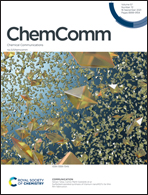Constructing highly sensitive ratiometric nanothermometers based on indirectly thermally coupled levels†
Abstract
Fluorescence intensity ratio-based temperature sensing with a self-referencing characteristic is highly demanded for reliable and accurate sensing. Lanthanide ions with thermally coupled levels have been widely used for ratiometric temperature sensing. However, these systems suffer from low relative temperature sensitivity and poor luminescence signal discriminability. Herein, the concept of indirectly thermally coupled levels is introduced and employed to actualize high performance temperature sensing. By means of the temperature-dependent phonon-assisted non-radiative relaxation, the 4I13/2 excited state (with infrared emission) of Er3+ can be indirectly thermally coupled with the 4S3/2 excited state (with visible emission) under 808 nm or 980 nm excitation. This is experimentally realized in specially designed NaErF4:10Yb@NaYF4 nanocrystals, and the corresponding ratiometric nanothermometer shows excellent luminescence thermal sensing performance with a maximum relative sensitivity value up to 3.76% K−1 at 295 K.



 Please wait while we load your content...
Please wait while we load your content...